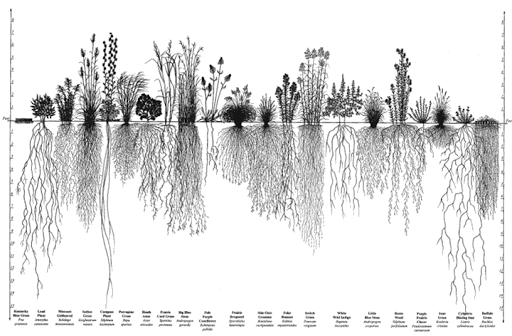

Free State Prairie
Lawrence Free State High School
Tallgrass Prairie
What is A prairie?
It's difficult to imagine the wide open landscape of the American Midwest as it existed for thousands of years before the arrival of Euro-American settlers. There were no roads, fences, or buildings. There were far fewer trees with woods only on hilltops or along streams and rivers that drained gently rolling hills covered in grass.
The prairie is a complex ecosystem with a rich assortment of organisms adapted to abundant sunlight and wide, seasonal fluctuations in temperature and precipitation. The prevalence of fire and animal grazers keep the prairie largely free from trees and shrubs which would otherwise shade out the sun-loving grasses and wildflowers.
Learn more about prairies from the Grassland Heritage Foundation, a local nonprofit that has worked with us over the years.

What kind of plants grow In A prairie?
The tallgrass prairie is dominated by grasses, some of which reach astounding heights of more than 7 feet! Most of these are called "warm season" grasses because they do most of their growing during the warmest part of the year. In addition to grasses, prairies are home to a wide variety of non-grass, non-woody flowering plants called forbs. Hundreds of different species of prairie plants flower at various times throughout the spring, summer, and fall to produce a beautiful, ever-changing array of colors and textures.


How Does Fire shape the prairie?
Before the arrival of Euro-American settlers, wildfires resulting from both lightning strikes and intentional fires set by native peoples regularly swept across the landscape. Unrestricted winds blowing across the wide open plains fueled the flames and, once ignited, a wildfire could reduce huge swaths of prairie to ash.
The plants that were able to survive under these conditions have their growing points underground and protected from fire. Trees and shrubs have their growing points above ground on their branches and are particularly vulnerable to fire. As a result, fire was a major force shaping the community of non-woody, deep-rooted plants in the tallgrass prairie.

Why are roots so important?
The climate of the Central Plains is moderately dry with droughts occuring periodically. Plants with deep root systems are more successful and have come to dominate the prairie landscape. Surprisingly, recent work suggests that in a normal year of rainfall, prairie grasses get most of their water from the top foot of soil beneath the prairie. However, the long roots growing through the layers of soil may be important in severe droughts, and they also transport minerals back to the surface.

Roots also create channels for water to soak further down into the soil. When roots die, they enrich the soil with organic matter and nutrients. With their complex root systems and growing points protected underground, prairie plants are able to rebound easily after fire has reduced their stems and leaves to nutrient rich ash. This repeated recycling of nutrients over thousands of years formed the deep, rich, soil of the prairie.

How do animals affect the prairie?
The diverse vegetation of the tallgrass prairie provides food for a variety of animals including deer, rodents, bison, birds, reptiles, amphibians, and insects.
Although grasshoppers are small in size, they are large in number and play a dominant role as grazers in the prairie. Grazing can stimulate plants to grow under certain conditions, and grazing mammals aerate the soil, transport seeds, and add nutrients back into the soil from their waste products.
Insects play a critical role in pollinating wildflowers and serving as a food source for a variety of other animals.
